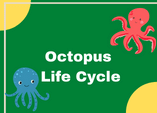Octopus Life Cycle Diagram Game Quiz
The octopus life cycle diagram game online for students to practice. Check out how a the octopus goes from egg to adult through visible physical changes. Biology lesson for students from 2nd to 7th grades.
 The life cycle of an octopus is fascinating. An octopus is a type of mollusk. They have three distinct phases: the adolescent, the juvenile, and the adult. The adolescent stage lasts for about a year. The octopus increases in weight five percent daily until it is fully grown. The common octopus lives for three to five years. They are very smart creatures and some have even been used to predict football games.
The life cycle of an octopus is fascinating. An octopus is a type of mollusk. They have three distinct phases: the adolescent, the juvenile, and the adult. The adolescent stage lasts for about a year. The octopus increases in weight five percent daily until it is fully grown. The common octopus lives for three to five years. They are very smart creatures and some have even been used to predict football games.
The male and female octopus species spend about four to five days together in the adult stage. This is a time of intense mating, and the male will often search for multiple mates in one day. The male will usually die within a month of mating with the female, and the female will carry fertilized eggs until they are hatched. The female octopus could lay up to a hundred thousand eggs. The eggs will survive and thrive until they are released, and the female will take care of them until they hatch. The octopus will die after two to 10 months.
At maturity, they begin to reproduce. Each pair produces one group of young adults. The male will unfortunately die a few months after mating, while the female will remain alive until the eggs hatch. The female will then take care of the eggs during the ten-month hatching period. The octopus population continues to grow and evolve for another few decades.
The chances of its eggs surviving to adulthood are low, since most might be eaten by predators. The lifespan of an octopus is typically between two and five years, depending on the species. During the reproductive stage, they reproduce and grow up quickly. Their rapid metabolic rate means they can grow as fast as five percent a day.
During the brooding stage, the female octopus stops eating and stays inactive for up to eight to ten days. The eggs are fertilized and the female octopus lays several eggs. The octopus will attempt to mate with other males. She does so by flashing its colors in order to attract them. Females are also known for their ability to protect their eggs.
When next you see this organism with several tentacles at sea, think about its interesting life cycle. Play this interactive game above to learn the different stages. This game can be used in classrooms and at home to review with your students. Tell us what you think. In the UK system of education, this is equivalent to science for year 2, year 3, year 4, year 5, year 6, year 7 and year 8.
